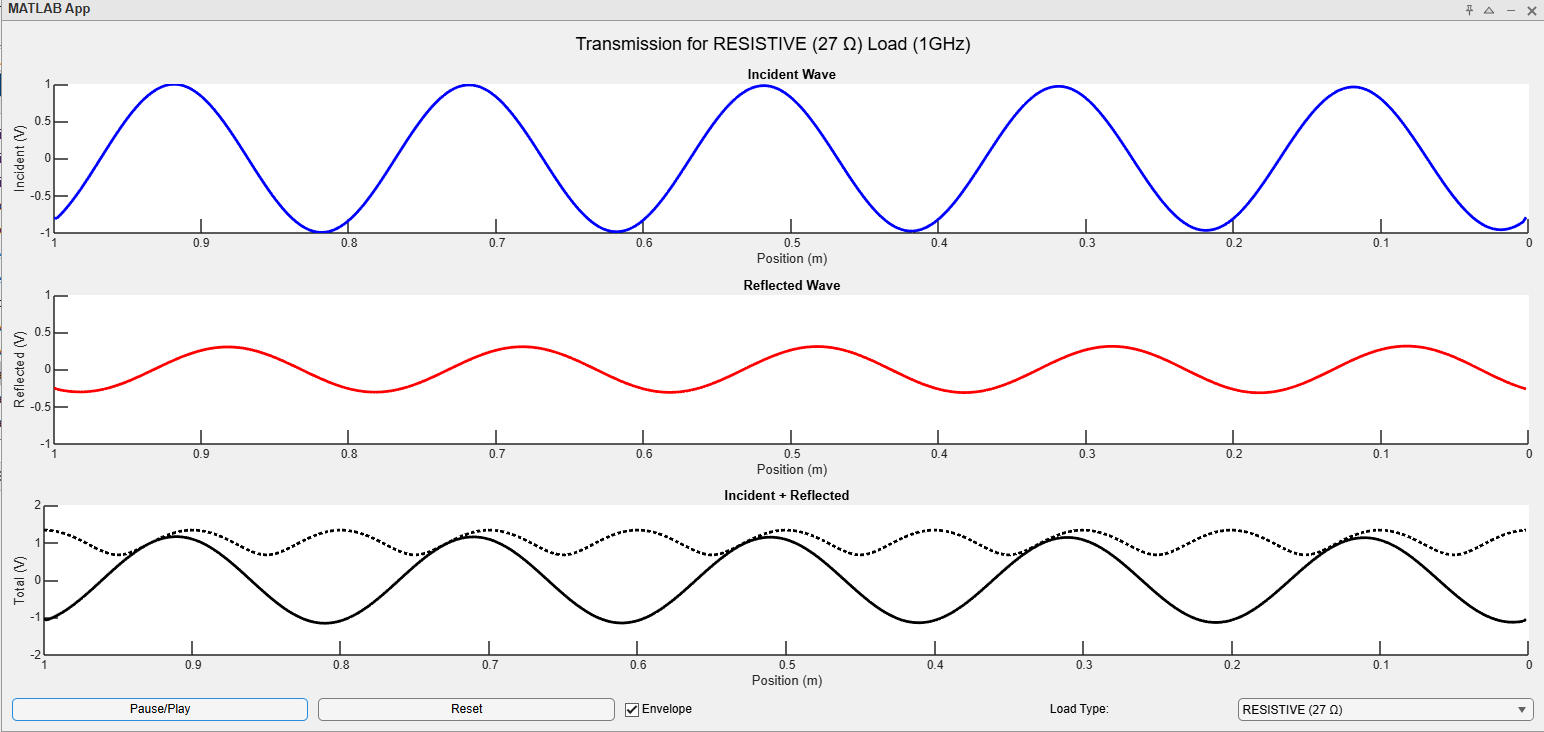8 Example 2-5 Sinusoidal Signal on Transmission line w/ various loads
APP LINK:
APPLICATION THUMBNAIL:
IN TEXT DESCRIPTION:
The sinusoidal transmission application below allows you to investigate how a 1 V sinusoidal signal interacts with short, open, resistive and matched loads. You may play or pause the simulation as well as reset entirely. There is an option to toggle the envelope for the incident + reflected wave for each load scenario.
SCREEN READER DESCRIPTION:
The sinusoidal transmission application allows you to investigate how a 1 volt sinusoidal signal interacts with short, open, resistive and matched loads. The application has three voltage against position graphs. Position is marked as distance from the load. The bottom graph shows a dotted line envelope overlayed on top of the incident plus reflected waveform. You may play or pause the simulation as well as reset entirely. There is an option to toggle the envelope for the incident + reflected wave for each load scenario.

VIDEOS:
Matched load:
IN TEXT DESCRIPTION:
For the matched load scenario, the incident wave is not reflected, so the reflected wave graph stays flat the entire time. Note that the envelope, then, is a flat 1 V line. See the sinusoidal transmission app for more.
SCREEN READER DESCRIPTION:
For the matched load scenario, the incident wave is not reflected, so the reflected wave graph stays flat the entire time. Note that the envelope, then, is a flat 1 volt line. The incident plus reflected graph also appears the exact same as the incident wave graph. See the sinusoidal transmission app for more.
open load:
IN TEXT DESCRIPTION:
For the open load scenario, the reflection coefficient is 1. Notice that as the reflected pulse propagates to the left, the incident plus reflected wave turns into a standing wave with an antinode located at the load. See the sinusoidal transmission app for more.
SCREEN READER DESCRIPTION:
For the open load scenario, the reflection coefficient is 1. As the reflected pulse propagates to the left, the incident plus reflected wave turns into a standing wave alongside the propagation of the reflected wave with an antinode located at the load. When the reflected wave arrives at the source, there is a standing wave in the incident plus reflected graph. It looks like a sine wave that does not shift left or right. Rather, its peaks shrink down to zero with time then increase again on the opposite side of the wave. In other words, the positive 1 volt peaks of the wave shrink to 0 then to -1 then return back to 1 volt. This pattern repeats. See the sinusoidal transmission app for more.
short load:
IN TEXT DESCRIPTION:
For the short load scenario, the reflection coefficient is -1. Notice that as the reflected pulse propagates to the left, the incident plus reflected wave turns into a standing wave with an node located at the load. See the sinusoidal transmission app for more.
SCREEN READER DESCRIPTION:
For the open load scenario, the reflection coefficient is -1. As the reflected pulse propagates to the left, the incident plus reflected wave turns into a standing wave alongside the propagation of the reflected wave with an node located at the load. When the reflected wave arrives at the source, there is a standing wave in the incident plus reflected graph. It looks like a sine wave that does not shift left or right. Rather, its peaks shrink down to zero with time then increase again on the opposite side of the wave. In other words, the positive 1 volt peaks of the wave shrink to 0 then to -1 then return back to 1 volt. This pattern repeats like the open load scenario. See the sinusoidal transmission app for more.
resistive load:
IN TEXT DESCRIPTION:
For the short resistive scenario, the reflection coefficient is a positive value less than one (TODO EDIT?) . Notice that as the reflected pulse propagates to the left, the incident plus reflected wave begins shrinking and increasing with time. See the sinusoidal transmission app for more.
SCREEN READER DESCRIPTION:
For the short resistive scenario, the reflection coefficient is a positive value less than one (TODO EDIT?) . As the reflected pulse propagates to the left, the incident plus reflected wave begins shrinking and increasing with time. It looks like the incident wave yet the entire wave enlarges in amplitude then shrinks in amplitude periodically. See the sinusoidal transmission app for more.
STILLS:
None??
Media Attributions
- SinusoidalLoadSimAppThumbnail

